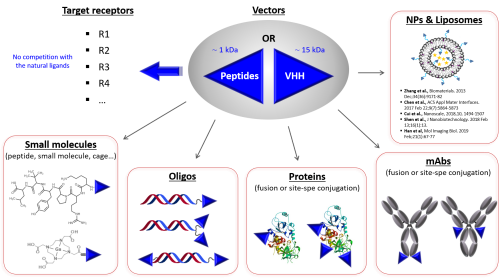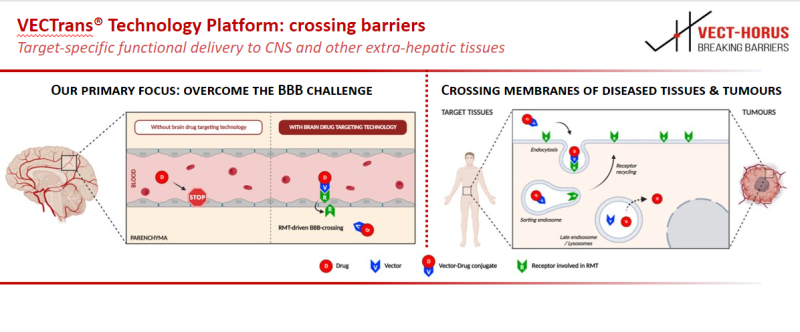Vect-Horus has developed and acquired a deep understanding of the rational design of new vector-payload complex for optimal targeted delivery in a given application. This expertise is key to increase therapeutic or diagnostic potential of new candidates.
All peptide- or small antibody-based vectors developed by Vect-Horus can be conjugated to low molecular weight organic molecules or large protein conjugates in a monovalent or multivalent format, in order to best control and optimize the vector/receptor interaction modalities. Multiple approaches have been developed to generate high quality investigational vector-payload complex. Beyond molecular-scale conjugates, our vectors are also amenable to conjugation to and decoration of any supramolecular delivery vehicle.
Specifically, Vect-Horus has developed a deep in-house expertise in the following fields:
- Protein engineering and vectorization: protein payloads (including antibodies or antibody fragments) can be conjugated to Vect-Horus’ vectors by genetic fusion and subsequently produced in different prokaryote or eucaryote systems to generate quality-controlled conjugates.
- Chemical coupling of Vect-Horus’ vectors to virtually any kind of therapeutic or imaging payloads: Vect-Horus can generate adequately functionalized building blocks for further conjugation using different linkers, either stable or cleavable in specific biological microenvironments.
Each vectorized payloads are delivered as quality-controlled and highly pure batches. Different techniques are used such as Size Exclusion Chromatography (SEC) to yield highly pure and monomeric conjugates, SDS-PAGE gel analysis and MALDI-TOF mass spectrometry as a control of their identity, molecular weight and purity,...
Vect-Horus has already established proof of concept of its VECTrans® technology in animals using molecules of different classes, thereby demonstrating the broad applicability and flexibility of its technology platform.

Small antibody- or peptide-based vectors, used in a monovalent or multivalent format, benefit from fast and efficient tissue penetration as well as controlled vector/receptor interaction modalities. These vectors can also be fused or chemically conjugated using site-specific chemical or enzymatic conjugation at their N-terminus or C-terminus to small organic molecules such as DOTA or NODAGA chelators, siRNAs, peptides, large biomolecules including antibodies, and Lipid NanoParticles (LNPs).
Vector properties can vary depending on the nature, the size of the payload, spacer or linker introduction and the coupling valency. Vect-Horus has developed and acquired a deep understanding of the rational design of new vector-payload complex for optimal targeted delivery. This expertise is key to increase therapeutic or diagnostic potential of new candidates.



